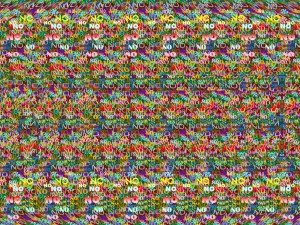Character versus character is, of course, not the only way to bring conflict into your story. Other avenues include character versus nature (dangerous terrain, wildlife, storms, floods…) or character versus self, where the character must overcome an aspect of themselves, such as their fears or the beliefs instilled by their upbringing, in order to be successful. Still, in stories with multiple characters, watching their personalities strike sparks off one another is a realistic and intriguing way of developing conflict. And conflict is the fuel that drives a plot – without an adversary to overcome, heroes sit around doing nothing.
The most obvious form of character versus character is hero versus villain. Other blogs this month talk about what makes a good villain, so I will add only this: a good villain sparks an interesting conflict with the hero. This statement encompasses both evil masterminds whose machinations drive the plots of whole series, all the way down to the minion who perhaps doesn’t survive his first and only interaction with the hero. Even that one-encounter minion can be memorable. Perhaps the hero realizes she can’t defeat this minion with strength, and has to use cunning, or endurance, or ask for help, instead. Perhaps it’s the first time the hero has ever had to kill in battle, or the first time she’s ever lost someone under her command. This conflict can involve both the fight itself (physical action, mental strategy, or both) and the aftereffects (emotional fallout; fatigue or lost gear heightening the hero’s conflict with her environment; the time delay heightening tension; etc).
Some of the most interesting conflicts are conflicts between protagonists. Just because a group of people are on the same quest, or in the same military unit, or working toward the same goal, doesn’t mean they’re going to all like each other. They may not even get along with one another. Aspects of their personalities are going to grate on one another. First impressions may create misunderstandings; past beliefs may shape prejudices or preconceptions. Different desires may set members of the same group working at odds to one another, or tempt one to betray the group; or threaten to splinter the group. These dynamics can lead groups to a vast array of outcomes, depending on the pressures placed on the group by the plot, and the choices made by the characters within the group. All that, and a villain besides!
Previous posts this month have dealt with romance, and one of the most elegant conflict generators – the love triangle – hinges on romantic attraction. If two characters (I’ll say a girl and a guy) like each other, there’s only so many ways to defer that mutual attraction before it’s acted upon. But if a girl likes two different guys, the writer has now set up two additional conflicts: the girl is forced to make a choice between the guys; and the guys are set in an adversarial relationship, competing against one another for the girl’s attention. Like any formula, this one can be tinkered with: for example, the girl who likes a guy who’s oblivious to her and doesn’t notice the second guy who dotes on her; or the “triangle” that becomes a square with the addition of a fourth character.
Love triangles don’t suit every story-category romance, for example, favours one hero and one heroine, and a story that illustrates how they overcome the obstacles in their path to a life together. Perhaps their conflict is generated by secondary characters: the disapproving family members; the crazy ex or jealous outsider, sowing misunderstandings to sabotage the relationship; the character who represents duty, such as a child, military unit or business obligation. A writer doesn’t even need romance to torment his hero with secondary characters such as these.
Without conflict, characters have nothing to do. Without disagreement, readers become bored watching the Happy Hero, and his Happy Friends who always act and think and feel exactly like their leader, wander on their Happy Way. But once the Happy Hero faces off against the Cunning Villain, with nobody at his side except: the alien with questionable loyalties; the attractive gunner who can’t get along with the equally attractive navigator; and the cranky sergeant who hates the villain only slightly more than she hates the hero; well, then the hero’s not always so Happy, and then you’ve got a story. A story that keeps readers hooked, wondering how those conflicts will play out.


